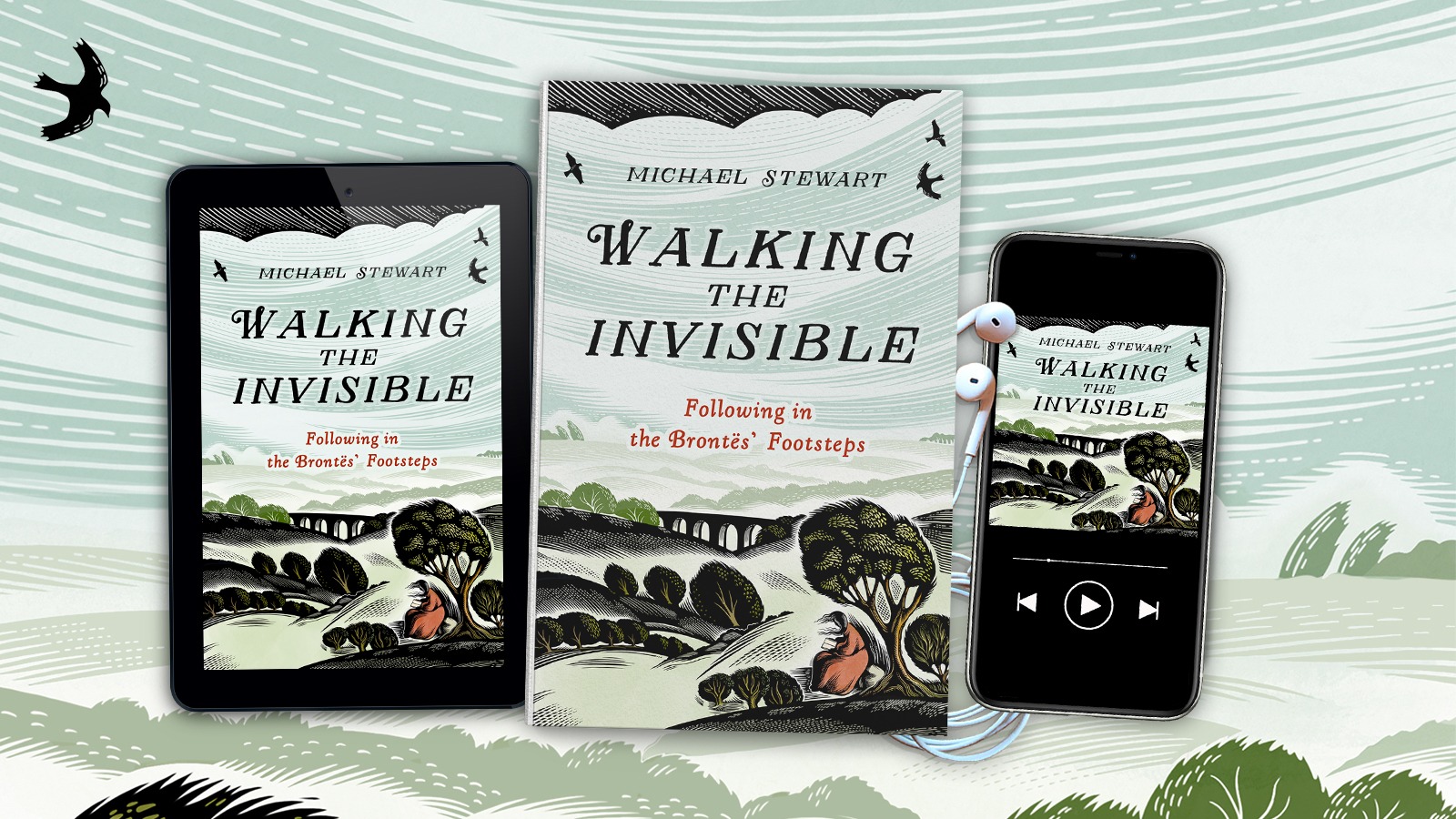Michael Stewart has been captivated by the Brontës since he was a child, and has travelled all over the north of England in search of their lives and landscapes. Now, he’d like to invite you into the world as they would have seen it. This is Walking the Invisible.
I’m standing in front of the gates of the former Law Hill School on Law Lane in Bank Top above Southowram, near Halifax. It is now a family home, but fastened to the outside wall is a newly sited blue plaque, which states that Emily Brontë, the author of Wuthering Heights, lived here from September 1838 to April 1839 and taught at Elizabeth Patchett’s school for girls, as it was then. These sixth months of work were the only paid employment Emily ever undertook. The work could be, by Emily’s own account, long and unpleasant. She wrote to Charlotte that it was ‘hard labour from six in the morning to near eleven at night … this is slavery’. Despite this, Emily managed to write a sequence of poems here that showed a new direction in her writing.
I’m here to explore the story of these poems and her time at Law Hill, to find out more about Emily’s inner life. I want to familiarise myself with the key places that inspired her only novel, which was to scandalise Victorian society. And I want to explore the story of Law Hill itself, but also the surrounding Walter Clough Hall, Shibden
Hall, High Sunderland Hall and the dramatic ground they cast their shadows over.
Although teaching at Law Hill was Emily’s only paid work, her sister Charlotte never referred to it by name, preferring instead to call it the ‘Halifax School’. This is odd, given that the school was a good few miles from Halifax. For some reason, Charlotte attributed the writing of the Law Hill poems to Emily’s time at Roe Head, when she was a seventeen-year-old pupil of the school. Why did Charlotte change the dates so that it looked like Emily had written the poems three years previously? And why was she so keen to avoid naming the school? Some biographers have put the change down to a memory lapse, but the poems are clearly dated in the manuscript Charlotte used.
We know that after the death of her siblings Charlotte changed quite a few details to make her family seem more respectable and orthodox; for instance, taking the reference to rape out of Anne’s The Tenant of Wildfell Hall. She also doctored both Anne and Emily’s poems, including those that Emily wrote as a teacher here in Southowram. Did something happen to Emily at Law Hill that Charlotte wanted to conceal? Charlotte wrote to her friend Ellen Nussey to explain that Emily had given up her teaching job at the ‘Halifax School’ due to ‘ill health’, explaining that she could only regain her health by being ‘re-established by the bracing moorland air and free life of home’. But Law Hill is in a remote spot, surrounded by splendid countryside not dissimilar to that of Haworth. And there is no evidence, other than Charlotte’s letter, that Emily was unwell. On the contrary, she appears to have been the most physically robust of all the sisters, traipsing over mire and moor, through rain and hail. Could it be possible that Charlotte was covering something up?
Law Hill was built by Jack Sharp, who is often cited as the main inspiration for the infernal character of Heathcliff. In the first half of the eighteenth century, Jack Sharp was adopted by John Walker of Walter Clough Hall, also in Southowram, about a mile from Law Hill. He was said to be an unscrupulous character who abused his uncle’s kindness. John Walker was a prosperous wool manufacturer and father to four children (Richard, John, Grace and Mary). But he most favoured his adopted son, who, through his deviousness, eventually managed to acquire much of Walker’s business. On John Walker’s death in 1771 (the year that Mr Earnshaw makes his trip to Liverpool in Wuthering Heights), Jack Sharp had full possession of the estate. But this wasn’t a legal status, and John’s eldest son, the rightful heir, mounted a challenge that he eventually won, ousting Jack in the process. Jack Sharp left, promising revenge. But not before stealing the family silver, as well as many other prized objects. He built Law Hill just one mile away so that it looked down on Water Clough Hall. He then enticed the easy-going son into gambling and ruin. He also man- aged to systematically degrade a young cousin of the heir, as Hareton Earnshaw was degraded by Heathcliff. Jack Sharp’s manservant was called Joseph, the same name as Heathcliff’s manservant, and the surname of one of Miss Patchett’s servants was Earnshaw.
Close by was High Sunderland Hall, the carvings above the door of which were similar to those of Wuthering Heights farmhouse. They included two griffins on the inside of the gateway and two misshapen nude men. A grotesque head formed the keystone to the arch of the gateway on the outside, while other heads with lewd faces peered from the cornices of the stonework. The hall was built on the edge of the moor in an exposed spot, similar to that of Wuthering Heights.
In other words, there is much of Law Hill and its surroundings that influenced Emily’s writing at this time. On 7 December 1838, halfway through her time at Law Hill, Emily wrote a poem quite different to the others she had been working on up to this point, which were poems relating to the fantasy world of Gondal that she and her sister Anne had immersed themselves in from childhood:
How still, how happy! These are words
That once would scarce agree together
I loved the plashing of the surge –
The changing heaven the breezy weather,
More than smooth seas and cloudless skies
And solemn, soothing, softened airs
That in the forest woke no sighs
And from the green spray shook no tears.
How still, how happy! now I feel
Where silence dwells is sweeter far
Than laughing mirth with joyous swell
However pure its raptures are
Come sit down on this sunny stone
’Tis wintry light o’er flowerless moors –
But sit – for we are all alone
And clear expand heaven’s breathless shores
I could think in the withered grass
Spring’s budding wreaths we might discern
The violet’s eye might shyly flash
And young leaves shoot among the fern
It is but thought – full many a night
The snow shall clothe those hills afar
And storms shall add a drearier blight
And winds shall wage a wilder war
Before the lark may herald in
Fresh foliage twined with blossoms fair
And summer days again begin
Their glory-haloed crown to wear
Yet my heart loves December’s smile
As much as July’s golden beam
Then let us sit and watch the while
The blue ice curdling on the stream.
This is uncharacteristic of Emily’s poems and expresses joy and happiness in a way that many of her others do not. The mood of the poem certainly doesn’t fit the sentiment she expresses in her letter to Charlotte. But who does the poem address? Who does she want to sit down beside her to share her love of the ‘flowerless moors’? As Brontë scholar Edward Chitham makes clear in his essay ‘Law Hill and Emily Brontë: Behind Charlotte’s Evasion’ in Brontë Studies, it is unlikely to have been a pupil, as the ‘alone’ implies that they are together for the first time without their pupils. It is, as Chitham again points out, more likely to be another teacher. One of Emily’s fellow teachers was a woman called Jane Aspden. By coincidence, Emily had visited Jane Aspden’s home when she was a girl. ‘Aspden’, also spelt ‘Aspen’ and ‘Aspin’, is the only English surname Emily ever uses in a Gondal poem, one called ‘Written in Aspin Castle’. I don’t want to jump to any undue conclusions, but it is not unreasonable to assume two things: one, that the two women were colleagues; and two, that they had things in common that would bond them in some way.
This isn’t the only theory concerned with Emily’s personal rela- tionships. For example, Sarah Fermi, in Emily’s Journal, maintains that Emily had a relationship with Robert Clayton, who died in 1836. And many readers and academics have been curious about how Emily is able to describe the love between Heathcliff and Catherine with such authentic passion. Of course, it’s not necessary to experience something to be able to write about it convincingly. Many authors write about murder, for example, without, we assume and hope, having first-hand knowledge. Shakespeare didn’t go to Denmark or Venice or North Africa. H.G. Wells never travelled in a time machine. Jules Verne never took a journey to the centre of the Earth. They made these things up. The imagination is a powerful tool. But that isn’t to say that Emily didn’t fall in love while she was at Law Hill. As I stand by the gate, so close to the moors that inspired Emily to write one of the most powerful accounts of obsessive and destructive love in English literature, it is tempting to wonder what really went on beneath its sturdy Georgian brickwork.
Walking the Invisible is out now in hardback, eBook and audio. Available here.





